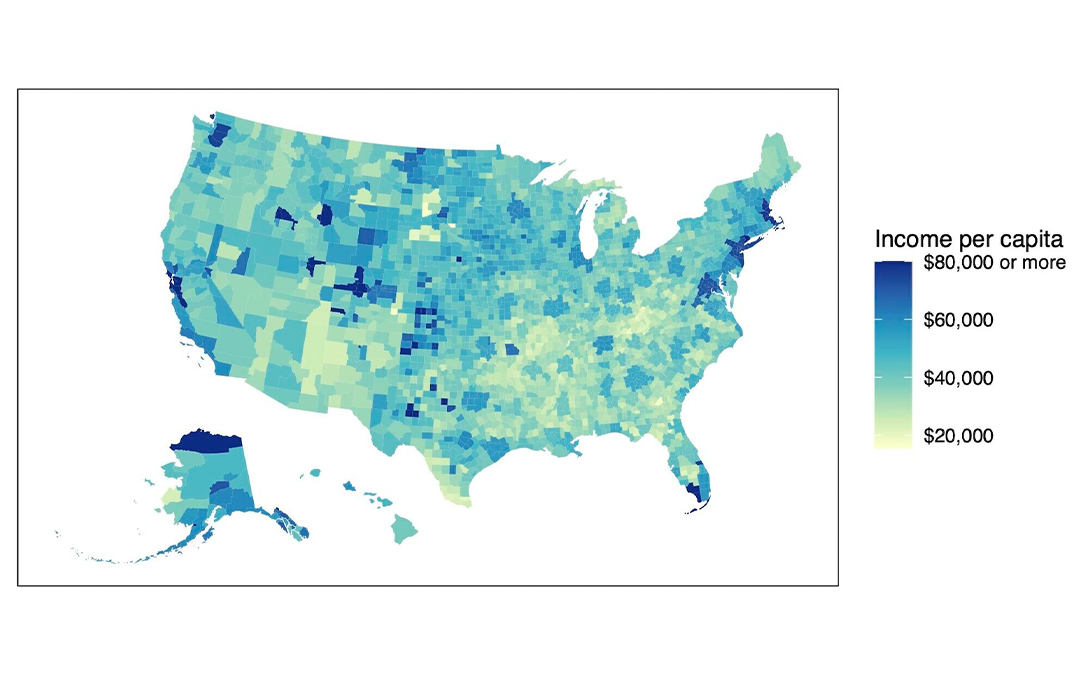
Social transfer programs have significant geographic differences in spending that help to reduce income gaps between rich and poor regions of the United States, according to new University of Michigan research.
The study, published in Social Service Review, shows that federal social insurance programs such as Social Security and the Earned Income Tax Credit reduced geographic inequality by 12% in 2019, equivalent to reversing more than 28% of the growth in inequality observed since the 1970s.
Despite being designed without an explicit goal of reducing regional disparities, these programs disproportionately benefit low-income areas. Retirement benefits caused the most significant total reduction in inequality. Spending-adjusted reductions were largest in veterans' benefits, the EITC and the Supplemental Nutrition Assistance Program.
"Social transfer programs have long been heralded for their individual-level benefits, but their role in reducing regional inequalities has often been overlooked. Given ongoing debates about federal social transfer programs, such as the Child Tax Credit, our findings offer a new dimension for policymakers to consider," said co-author Catalina Anampa Castro, U-M doctoral student in sociology and public policy.
Inequality has risen across the United States, with significant geographic disparities emerging over the past four decades. Early in the period under study, higher incomes were seen in metro areas in the upper Midwest and the rural interior West. However, these areas have experienced relative income declines compared to the rest of the country.
"High levels of inequality and the geographic income gap between areas like San Francisco and rural regions are pivotal challenges facing the U.S.," said co-author Robert Manduca, U-M assistant professor of sociology and faculty affiliate at the Stone Center for Income Dynamics at the Institute for Social Research.
"Examining social insurance programs that were not initially aimed at reducing regional disparities, we found they nonetheless contribute significantly to narrowing these gaps."
Geographic variation in income and transfer spending
In 2019, per capita personal income—comprising market income and transfers—varied widely across the country. The highest income was recorded in the Jackson metropolitan area (Wyoming and Idaho) at $163,370, while Buffalo County (South Dakota) was at the bottom with $15,679. This disparity highlights the substantial economic gap between various regions.
Transfer program spending also showed substantial variation. The Villages, Florida, received the highest per capita transfer spending at $12,316, while the Aleutians West Census Area, Alaska, received the lowest at $2,183.
Transfer spending was higher in rural areas such as the northern Midwest, Appalachia and parts of the rural South, Southwest and Pacific coast. In contrast, metropolitan areas, some rural parts of Texas and the interior West saw lower transfer amounts.
Areas where transfers constituted the highest percentage of local income were often poor but not the poorest, suggesting a nuanced relationship between income levels and transfer reliance.
The study also found a negative correlation between transfer spending and total income. Regions with lower total incomes received higher per capita transfers.
Implications for policy and future research
The research encourages a reevaluation of federal vs. state roles in social welfare programs. Future studies might explore the impact of taxes on geographic inequality and the potential effects of Medicaid spending.
"Our research suggests that expanding federal social transfer programs could further alleviate these regional disparities," said co-author Analidis Ochoa, a U-M doctoral student in sociology and social Work. "There is increasing political tension due to interregional inequality. Additionally, these federally administered programs outperform state-level ones in addressing such inequalities due to consistency in implementation, free from local political influences.
"When states have more discretionary spending, the money is often distributed in more unequal ways because the state diverts funds to whatever the political ideology is at the time."
Understanding these geographic disparities is crucial for policymakers aiming to reduce inequality and improve economic conditions in underserved regions.
"As the economy in parts of the country has gone downhill, we've seen declining upward mobility and increasing health problems," Manduca said. "There's a need for research that ties social and economic conditions together."
Written by Fernanda Pires, Michigan News
